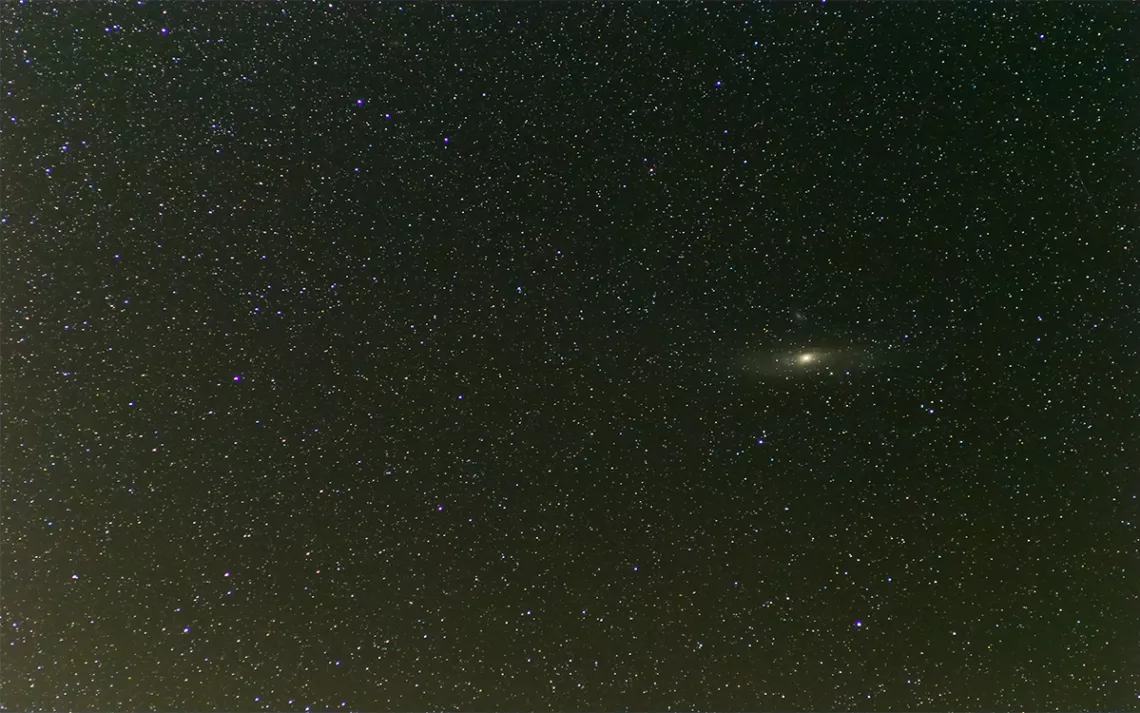September Astronomical Highlights: Andromeda Galaxy and a Comet
The full harvest moon leads the way to asterisms and a galaxy

Photo by Yuriy_Kulik/iStock
Relief from the heat of summer and long days baking in the sun is on its way. The Northern Hemisphere’s fall equinox occurs on September 22 at 6:54 P.M. PDT. The harvest moon—the full moon that comes closest to the equinox—is just two nights later, on September 24 at 7:53 P.M. PDT. On this date, the moon is in the constellation Pisces.
As you admire the full harvest moon, turn your gaze higher in the sky to find a circle, square, and distant galaxy. The round shape close to the full moon is the Circlet of Pisces, part of the constellation of the fish. Above the Circlet and spanning a much larger swath of sky is the Great Square of Pegasus. The constellation of Pegasus rises in the east in September, with the asterism (grouping of stars) set more on end like a diamond. Imagine a large baseball diamond in the sky, with home plate nearest to the horizon. The star marking third base, Alpheratz, is actually not part of the constellation Pegasus but part of neighboring Andromeda.
While you’re gazing at Alpheratz, measure 15 degrees to the left of the star to reach the Andromeda Galaxy. An easy way to do this is to stretch your arm out and create a fist, then extend and spread out your pinkie and index fingers (rock on). The distance between these fingers should mark about 15 degrees of sky and get you in the vicinity of Andromeda. You’ll probably need binoculars to see it. Now that you know where to find Andromeda, try again on a moonless night and away from artificial sources of light. You may even be able to find it without optical aid.
Four Bright Planets
This month, Venus, Jupiter, Saturn, and Mars are arrayed across the sky from west to southeast. On September 1, Venus is quite close to the star Spica in Virgo, and the pair can be found near the horizon soon after sunset. Venus is the easiest to find because it’s so much brighter than all the other points of light in the sky, but it sets shortly after the sun. A crescent moon is wide of Venus on September 11 and then above Venus on September 12.
On September 13, the slowly growing crescent moon is close to Jupiter in the constellation Libra. The somewhat bright star closest to Jupiter is Zubenelgenubi. By September 17, the moon has evolved to slightly more than half full and hop-scotched over Saturn, which is not far from the center of the galaxy. When you look toward Saturn, you are looking toward the heart of the Milky Way.
Lastly, the moon meets up with Mars on September 19 in Capricornus. Mars is coming down from its “high” of opposition when it was particularly bright. The Red Planet will start September brighter than Jupiter but dim steadily until Jupiter once again surpasses it.
With all the bright planetary targets in September, there's one planet that’s a fun challenge to try to find. Neptune reaches opposition on September 7 at magnitude 7.8. You’ll need optical aid to see it. Because it’s so dim, it’s difficult to distinguish from background stars. The best time to see Neptune is not necessarily opposition but whenever a brighter planet skims past it so you can focus your binoculars or telescope on the easy-to-find planet and then spot Neptune popping up in the background. You’ll have to wait until December for just such a close encounter between Neptune and Mars.
Comet Giacobini-Zinner Nears Naked-Eye Visibility
You might get to see a comet without optical aid in September. Comet 21P/Giacobini-Zinner might reach naked-eye visibility around September 10 in dark-sky locations. Start during the first couple days of the month by looking near the bright star Capella in Auriga, found in the northeastern sky after dark. Capella should be easy to find because it’s the brightest star rising in this region of sky.
With binoculars, search for the comet by sweeping the area near Capella and looking for a hazy, diffuse area of light that stands apart from the pinpricks of stars. The comet won’t stay near Capella for long, however. Each night it dives closer to the horizon, so you’ll have to stay up later as September wears on to be sure the comet has risen and is visible.
By September 19, the comet is positioned between the constellations of Gemini the Twins and Orion. (The comet will be a wide left of Orion’s reddish shoulder star Betelgeuse.) By the end of September, the comet is nearing Sirius in the constellation Canis Major. Giacobini-Zinner will complete a large loop around the Greater Dog over the coming months as it slows its progress through the sky and dims until it’s out of the reach of most backyard telescopes.
 The Magazine of The Sierra Club
The Magazine of The Sierra Club



